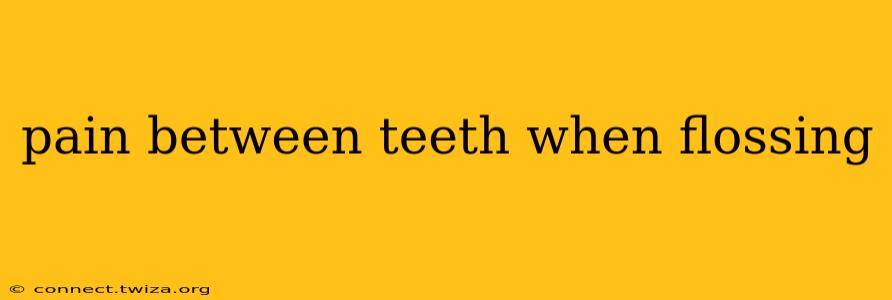Flossing is crucial for maintaining optimal oral hygiene, yet many experience discomfort or even pain between their teeth while doing so. This shouldn't be dismissed; it's a signal that something might be amiss. This comprehensive guide delves into the common causes of this pain, effective solutions, and preventative measures to ensure a pain-free flossing experience.
Why Does My Gums Hurt When I Floss?
Gum pain during flossing is often the most common complaint. This is usually due to gingivitis, an early stage of gum disease characterized by inflamed and bleeding gums. The inflammation makes the gum tissue sensitive, causing pain when the floss disturbs it. Poor flossing technique can also exacerbate this, leading to further irritation.
What Causes Pain Between My Teeth When Flossing?
Several factors can contribute to pain between your teeth when flossing, beyond simple gum inflammation:
1. Gingivitis and Gum Disease:
As mentioned above, inflamed gums are a primary culprit. Bacteria buildup along the gumline causes inflammation, making the area tender and sensitive to touch. Ignoring gingivitis can lead to periodontitis, a more severe form of gum disease that damages the supporting structures of your teeth.
2. Improper Flossing Technique:
Aggressive flossing, snapping the floss between teeth, or using too much force can injure the gum tissue, causing pain and bleeding. The correct technique involves gentle, C-shaped movements against the tooth surface, avoiding snapping.
3. Food Impaction:
Food particles lodged between teeth can irritate the gums and make flossing painful. These particles create an environment where bacteria thrive, further contributing to inflammation.
4. Cavities:
A cavity, particularly one that has progressed beyond the enamel, can be extremely sensitive to the pressure of floss. The exposed dentin is highly sensitive to temperature and touch, resulting in pain.
5. Receding Gums:
Receding gums expose the root surfaces of teeth, which are more sensitive than enamel. The exposed roots are more susceptible to irritation and pain when flossed. Receding gums are often a symptom of gum disease.
6. Orthodontic Appliances:
Individuals with braces or other orthodontic appliances may experience pain between teeth when flossing due to the added pressure and sensitivity around the brackets and wires. Special floss threaders can help navigate around these obstacles.
7. Newly Erupted Wisdom Teeth:
The emergence of wisdom teeth can cause pain and inflammation in the surrounding tissues, making flossing uncomfortable.
8. Recent Dental Work:
After dental procedures like extractions, fillings, or deep cleaning, the area may be sensitive and painful for a few days, making flossing temporarily challenging.
How Can I Make Flossing Less Painful?
Addressing the underlying cause is key to alleviating flossing pain. However, there are ways to make the process more comfortable in the meantime:
- Use the right floss: Try different types of floss, such as waxed or unwaxed, flavored or unflavored, to find what feels best for your gums. Dental tape, being wider, may be more comfortable for some.
- Use a floss threader: This helpful tool is particularly beneficial for people with braces or tight contacts between teeth.
- Use a water flosser: A water flosser can effectively remove food particles and plaque without the direct friction of floss.
- Be gentle: Avoid snapping the floss between your teeth. Use gentle, C-shaped motions to clean each tooth surface.
- Floss more frequently: Regular flossing can help prevent the buildup of plaque and food particles, reducing inflammation and discomfort. Daily flossing is ideal.
- Improve flossing technique: Consider watching videos or consulting your dentist for guidance on proper flossing technique.
When Should I See a Dentist About Flossing Pain?
Persistent pain, bleeding, or swelling despite good flossing habits warrants a visit to your dentist. They can diagnose the underlying cause of your discomfort, provide professional cleaning, and recommend appropriate treatment. Don't hesitate to seek professional help if you experience:
- Severe pain during flossing.
- Persistent bleeding.
- Swelling or redness of the gums.
- Receding gums.
- Loose teeth.
- Pus or foul odor around teeth.
Regular dental checkups and professional cleanings are crucial for preventing and managing gum disease, ensuring that flossing remains a comfortable and effective part of your oral hygiene routine. Ignoring pain can lead to more serious dental problems down the line, so proactive care is essential.
